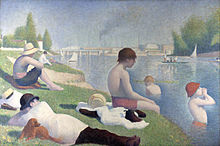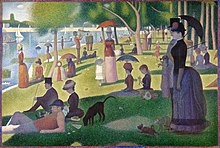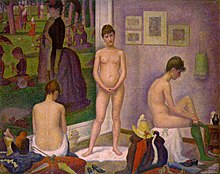Georges Seurat
Georges-Pierre Seurat ([ ʒɔʁʒ pjɛʁ sø'ʁa ]; * December 2, 1859 in Paris ; † March 29, 1891 ibid) was a French painter and draftsman and, next to Paul Signac , the most important exponent of pointillism .
Life
Childhood and youth
Georges-Pierre Seurat was born on December 2nd, 1859 at 60 rue de Bondy in Paris. His father was a retired bailiff who had amassed a small fortune. He lived in seclusion in his summer home in Le Raincy and visited his family only once a week. Georges Seurat's mother, Ernestine Faivre, came from a wealthy middle-class Parisian family. Between 1869 and 1876 Seurat attended various high schools, during the government of the Paris Commune from March 18 to May 28, 1871, the Seurat family left Paris and lived in Fontainebleau . While at school he was introduced to painting by his uncle Paul Haumonté-Faivre, a textile merchant and amateur painter. From 1875 to 1877, Georges Seurat also took part in drawing courses at a city evening school, led by the sculptor Justin Leqquien . During this time he worked on the book "Grammar of the Art of Drawing" by Charles Blanc , in which he encountered the idea that color is subject to laws that can be taught. In the drawing course, Seurat also met Edmond Aman-Jean , with whom he became friends and was admitted to the École des Beaux-Arts in February 1878 . On March 19, 1878, Seurat entered the painting class of Henri Lehmann , a less important student of Jean-Auguste-Dominique Ingres , where he met Ernest Laurent . He also studied the Old Masters at the Louvre .
Working life
In 1879, Georges Seurat left the École des Beaux-Arts. This decision came after a visit to the 1879er exhibition of the Impressionists , in which images of Edgar Degas , Camille Pissarro and Claude Monet were seen. Seurat increasingly turned away from academic ideals. Together with Edmond Aman-Jean and Ernest Laurent, he rented a studio in the Rue de l'arbalète. Between November 1879 and November 1880 Seurat did his military service in Brest . Meanwhile he made sketches and read "The Phenomena of Seeing" by David Sutter . After returning from Brest, he rented a room in the rue de Chabrol, in which he subsequently painted his works. Like almost no other artist, he dealt with optical problems and dealt with physics, geometry and various theoretical works. Among other things, he studied Eugène Chevreul's work on the simultaneous contrast of colors and the color wheel . In 1881, Seurat made a few small trips to the Paris region with Aman-Jean. In the course of his theoretical studies, he dealt with the color theory of Ogden Nicholas Rood and dealt with the works of Eugène Delacroix ', who had made experiments with the system of complementary colors in the Saint-Agnes chapel in Saint-Sulpice . Seurat discussed dynamogeny with Charles Henry , which the young scientist used to describe the theory of contrast, rhythm and measure. Based on his preoccupation with color theories, Seurat carried out experiments on wooden panels and canvases, first with color mixtures, then with separate color dots.
Georges Seurat was in 1883 for the first time and for the only time in the Paris Salon represented. His drawing Portrait of Aman-Jean was shown there. The following year, Seurat's first large painting, A Bathing Area near Asnières, was rejected by the Salon. Instead, this picture was presented in the exhibition of the Societé des Artistes Indépendants . There he met Paul Signac , with whom he subsequently became friends. In the following year, Signac introduced him to the artistic avant-garde and the circle of symbolist writers. In contrast to many other artists of the time, he was not surrounded by a large number of admirers and was particularly popular with the public. Seurat maintained contacts with the last painters of realism, as well as with symbolists and decadents. In 1886, Seurat exhibited his painting A Sunday Afternoon on La Grande Jatte Island and nine other works in the last Impressionist exhibition. His painting style was explained in detail and factually by the art critic Félix Fénéon . The Belgian poet Émile Verhaeren invited Georges Seurat to the next exhibition of the avant-garde group " Les Vingt ". In the fall of 1886, Seurat moved into his new studio on Boulevard de Clichy.
Last years and death
On February 2, 1887, Georges Seurat and Signac participated in the opening of the Les Vingt exhibition. There he was represented with seven paintings. In the same year, the group of Neo-Impressionists founded by Signac was formed , in which among others Charles Angrand , Maximilien Luce and Albert Dubois-Pillet were representatives of the pointillist painting technique alongside Seurat. In January 1888, Georges Seurat exhibited alongside his artist friends in the premises of the "Revue Indépendante" directed by Fénéon. In the summer he traveled to the English Channel . There he made numerous seascapes. In February of the following year, Seurat took part for the second time in the exhibition of the artists' association Les Vingt in Brussels. Confused by internal disputes, Seurat increasingly distanced himself from his friends. He met Madeleine Knobloch , with whom he lived from October in a studio in the Passage de l'Élysée-des-Beaux-Arts.
Madeleine Knobloch gave birth to Seurat's son Pierre Georges on February 16, 1890. Jules Christophe dedicated a booklet to Georges Seurat , which appeared in the “Les Hommes d'Aujourd'hui” series directed by Fénéon. He spent the summer in Gravelines . There he painted seascapes on the North Sea again. In the exhibition of the Brussels artist group Les Vingt in 1891, Georges Seurat took part again and showed the picture Le Chahut and six landscape paintings. In the Salon des Indépendants he showed the still unfinished picture Circus .
On March 29, 1891, Georges Seurat died of diphtheria . Two days later he was buried in the Père Lachaise cemetery in Paris. His son died a short time later from the same disease. Paul Signac, Félix Fénéon and Maximilien Luce made an inventory of Seurat's estate on May 3, 1891 in Seurat's studio. His lover Madeleine Knobloch received some works as inheritance and, as a result of disputes, turned away from the Seurat family.
Works (selection)
For the complete pictorial works of Seurat see the list of paintings by Georges Seurat .
- Forest in Pontaubert , 1881, Metropolitan Museum of Art , New York
- Morning Walk , 1885, National Gallery , London
- Le Bec du Hoc , 1885, Tate Gallery , London
- Le Bec du Hoc, Grandcamp , 1885, Tate Gallery, London
- Le port d'Honfleur , 1886, Kröller-Müller Museum , Otterlo
- Les Poseuses , 1888, Barnes Foundation , Philadelphia
- An evening on the Gravelines Canal , 1890
- The circus , 1890/1891, Musée d'Orsay , Paris
The Mower , 1881/82, Metropolitan Museum of Art, New York
In the art market today, up to 1.5 million US dollars are paid for his oil paintings.
Exhibitions
In 1964, his works were shown in the hand drawings department at documenta III in Kassel .
From November 2, 2009 to January 17, 2010 the Kunsthaus Zürich showed more than 70 paintings and drawings from major public and private collections in London, Paris, New York and Washington. This exhibition then went to the Schirn Kunsthalle in Frankfurt am Main , where it was titled Georges Seurat from February 4 to May 9, 2010 . Figure was shown in space .
Honors
The 1977 discovered asteroid (6678) Seurat was named after him.
literature
- Literature by and about Georges Seurat in the catalog of the German National Library
- Rainer Budde: Pointillism. In the footsteps of Georges Seurat. Prestel, Munich 1997, ISBN 3-7913-1840-3 .
- Pierre Courthion: Georges Seurat. DuMont, Cologne 1991, ISBN 3-7701-2701-3 .
- Erich Franz and Bernd Grove: Georges Seurat - drawings. Prestel, Munich 1984, ISBN 3-7913-0650-2 .
- Georges Seurat: Painting in a nutshell. Taschen, Cologne 1999, ISBN 3-8228-6374-2 .
Web links
- Works by and about Georges Seurat in the German Digital Library
- Search for Georges Seurat in the SPK digital portal of the Prussian Cultural Heritage Foundation
- Georges Seurat on kunstaspekte.de
- Works by Georges Seurat at Zeno.org .
- www.artelino.de (short biography)
Individual evidence
- ^ Pierre Courthion: Georges Seurat . DuMont, Cologne 1991, page 12.
- ^ Pierre Courthion: Georges Seurat . DuMont, Cologne 1991, page 13.
- ↑ a b Pierre Courthion: Georges Seurat. DuMont, Cologne 1991, page 14.
- ^ Pierre Courthion: Georges Seurat. DuMont, Cologne 1991, page 18.
- ^ Pierre Courthion: Georges Seurat. DuMont, Cologne 1991, page 19.
- ↑ Georges Seurat: Painting in a nutshell. Taschen Verlag, Cologne 1999, page 95.
- ↑ Overview on the website of the international auction house Christie's , accessed on November 10, 2012
| personal data | |
|---|---|
| SURNAME | Seurat, Georges |
| ALTERNATIVE NAMES | Seurat, Georges-Pierre (full name) |
| BRIEF DESCRIPTION | French painter and representative of pointillism |
| DATE OF BIRTH | December 2, 1859 |
| PLACE OF BIRTH | Paris |
| DATE OF DEATH | March 29, 1891 |
| Place of death | Paris |










